Cesky Krumlov Attractions: Cesky Krumlov Castle, Baroque Theatre and the Revolving Auditorium
By Tracy A. Burns
The jewel of Český Krumlov is its castle and chateau, the second largest castle complex in the country after Prague Castle, with its five courtyards and 11 hectares of gardens. On the UNESCO world heritage and natural heritage list, the complex offers two tours of the chateau and a third of the Baroque theatre. A revolving auditorium can be found in the park.
History
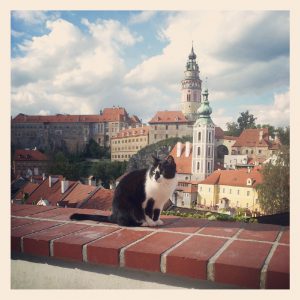 Built by the Lords of Krumlov, the Hrádek or “little castle” in Český Krumlov dates back to before 1250. The Rožmberks (sometimes known as Rosenbergs), with the five-petalled red, rose on their coat-of-arms, came in 1302 and stayed until the clan died out in 1602. During their 300-year reign, the chateau was transformed into Renaissance style. After the Rožmberks, the chateau came into the hands of Habsburg Emperor Rudolf II, and his mentally ill son, Don Julius d’Austria, called the chateau home from 1605 to 1608. During his tenure there, he murdered the barber’s daughter, Markétka. (A painting of the murder can be seen on the route I chateau tour.) The Eggenbergs was next to arrive, residing there from 1622 to 1719. Culture flourished here under the rule of Jan Kristián of Eggenberg. The Schwarzenberg family obtained the chateau in 1719 and held onto it until the complex was nationalized in 1947. It was Duke Josef Adam of Schwarzenberg who gave the chateau a Rococo makeover.
Built by the Lords of Krumlov, the Hrádek or “little castle” in Český Krumlov dates back to before 1250. The Rožmberks (sometimes known as Rosenbergs), with the five-petalled red, rose on their coat-of-arms, came in 1302 and stayed until the clan died out in 1602. During their 300-year reign, the chateau was transformed into Renaissance style. After the Rožmberks, the chateau came into the hands of Habsburg Emperor Rudolf II, and his mentally ill son, Don Julius d’Austria, called the chateau home from 1605 to 1608. During his tenure there, he murdered the barber’s daughter, Markétka. (A painting of the murder can be seen on the route I chateau tour.) The Eggenbergs was next to arrive, residing there from 1622 to 1719. Culture flourished here under the rule of Jan Kristián of Eggenberg. The Schwarzenberg family obtained the chateau in 1719 and held onto it until the complex was nationalized in 1947. It was Duke Josef Adam of Schwarzenberg who gave the chateau a Rococo makeover.
The route I tour: The chapel
The Chapel of Saint George starts off the route I tour. Originally built in Gothic style, it was transformed into Rococo in 1753. A white statue of King George fighting a dragon is placed above the 19th-century center altarpiece showing the Virgin Mary and child. There are two side altars as well, and the walls are creamy artificial marble. The organ hails from 1750 and still works.
The Masquerade Hall
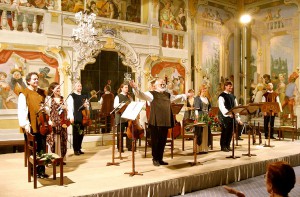 The fin de siécle of the route I tour is the lively, brightly colored Masquerade Hall, painted in Rococo style in 1748. This former ballroom and theatre space features murals of 135 people at a carnival: there are Chinese, Turks, Moors, and Commedia dell’ Arte personalities such as The Doctor and The Harlequin. Two painted life-size guards wearing furry hats stand at attention at the entrance to the room. Even the artist and his assistant have added their self-portraits to niches. The figures even have shadows. Look for the man falling over the theatre balcony or the half-man/ half-woman. One figure, dressed in red with a black hat, has a huge head and a diminutive body as if seen through a distorting mirror at an amusement park. Many glass chandeliers adorn the room.
The fin de siécle of the route I tour is the lively, brightly colored Masquerade Hall, painted in Rococo style in 1748. This former ballroom and theatre space features murals of 135 people at a carnival: there are Chinese, Turks, Moors, and Commedia dell’ Arte personalities such as The Doctor and The Harlequin. Two painted life-size guards wearing furry hats stand at attention at the entrance to the room. Even the artist and his assistant have added their self-portraits to niches. The figures even have shadows. Look for the man falling over the theatre balcony or the half-man/ half-woman. One figure, dressed in red with a black hat, has a huge head and a diminutive body as if seen through a distorting mirror at an amusement park. Many glass chandeliers adorn the room.
“The Division of the Rose”
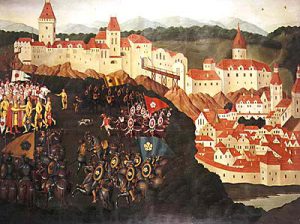 A painting depicting a prominent legend hangs in one hallway. “The Division of the Rose” shows the Wittigons, then the owners of the Český Krumlov chateau, dividing their property among their five sons. Each man receives a coat-of-arms portraying a five-petalled rose in a different color. The Rožmberk soldier dressed in golden armor is adorned with a red five-petalled rose, which would become a symbol of the chateau and town. Such a rose can be viewed in the antechamber, for instance, where guests once waited under a wooden, coffered, painted Renaissance ceiling decorated with red five-petalled roses on each panel.
A painting depicting a prominent legend hangs in one hallway. “The Division of the Rose” shows the Wittigons, then the owners of the Český Krumlov chateau, dividing their property among their five sons. Each man receives a coat-of-arms portraying a five-petalled rose in a different color. The Rožmberk soldier dressed in golden armor is adorned with a red five-petalled rose, which would become a symbol of the chateau and town. Such a rose can be viewed in the antechamber, for instance, where guests once waited under a wooden, coffered, painted Renaissance ceiling decorated with red five-petalled roses on each panel.
The Eggenberg Hall
Another masterpiece on the tour is the gold carriage dominating the Eggenberg Hall, dedicated to the Eggenberg family that owned the castle for almost 100 years during the 17th and 18th centuries. The carriage is decorated in gold and carved out of nut wood. Don’t miss the female figure in a sea shell and the ornate wheels. The carriage was constructed in Rome in 1638 for the occasion when Johann Anton von Eggenberg was announcing to Pope Urban VIII that Ferdinand III had been chosen, as emperor. Presents for the Pope filled the carriage as it traveled a few kilometers from Rome to the Vatican.
The hunting accident
Chateau owner Prince Adam František Schwarzenberg was a high-ranking official working for Holy Roman Emperor Charles VI. At the end of May in 1732, the emperor and Adam František went on a hunting trip to Brandýs nad Labem near Prague. Aiming at a deer, Emperor Charles VI accidentally shot the prince. Adam František died the following day. The police protocol for the hunting accident is displayed on an inlaid writing table.
Route II tour
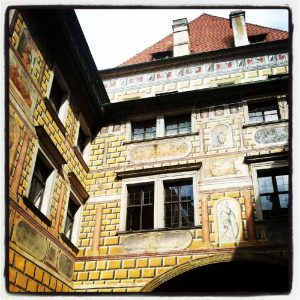 Make sure you take the route I tour, and, if you have more time, go on the second tour as well. The route II tour concentrates on the 19th century when Schwarzenbergs lived there. Portraits of Schwarzenberg family members from the 14th century to 1918 adorn one room. Notice the portraits of Joseph Adam, who renovated the chateau in Rococo style. A marble bust depicts Frederick, archbishop of Prague and later Cardinal. A portrait of Felix von Schwarzenberg, who served as Prime Minister of Austria from 1848 to 1852, can be seen here, too. The Gentleman’s Room includes 114 English etchings of the romantic landscape while the Music Salon features a 19th-century Viennese piano that still functions.
Make sure you take the route I tour, and, if you have more time, go on the second tour as well. The route II tour concentrates on the 19th century when Schwarzenbergs lived there. Portraits of Schwarzenberg family members from the 14th century to 1918 adorn one room. Notice the portraits of Joseph Adam, who renovated the chateau in Rococo style. A marble bust depicts Frederick, archbishop of Prague and later Cardinal. A portrait of Felix von Schwarzenberg, who served as Prime Minister of Austria from 1848 to 1852, can be seen here, too. The Gentleman’s Room includes 114 English etchings of the romantic landscape while the Music Salon features a 19th-century Viennese piano that still functions.
The tapestries, the portrait gallery, and the Cloak Passage
The Schwarzenbergs owned 87 Dutch and Flemish tapestries, some of which are sprinkled throughout the rooms. The family’s coat-of-arms, dominated by a Turk’s head to celebrate a victory over the Turks and also adorned with white and blue stripes, is also often visible. In one room a tapestry features the clan’s coat-of-arms. In the Princess’ Bedroom, Dutch tapestries dating from 1620 to 1630 tell the tale of Aeneas, a protagonist in the Trojan Wars. A portrait gallery shows off the artwork by German, Italian, Dutch and Flemish masters, such as “The Adoration of the Magi” by Paolo Veronese and “The Holy Family” by Peter Paul Rubens. Yet another depicts the fire of Troy, but the painter has added a Gothic cathedral to his depiction. Baroque maps line the Cloak Passage on the painted bridge. Take in the view of the orange rooftops from the bridge’s windows.
The legend of the White Lady
The legend of the White Lady ghost permeates the chateau. The beautiful daughter of Ulrich II of Rožmberk, Perchta of Rožmberk spent many cheerful days as a child growing up in the chateau. However, her father forced her to marry Jan von Lichtenstein, a distinguished noble who was widowed. A violent man, Lichtenstein was very abusive toward his wife. Indeed, Perchta was no stranger to unbearable suffering. The mother and sister of her husband’s deceased wife also harassed her. She was trapped in her miserable marriage. Then her husband died, and she returned to Český Krumlov, but she never smiled again and always looked sad. She died at age 49 in 1476, but her ghost, known as the White Lady, used to walk through the rooms of Český Krumlov chateau or other castles belonging to the Rožmberk family. She would always be wearing a white dress, keys fastened to her waist. If she smiled, the future would bring good fortune, but if she donned black gloves, disaster or death filled the forecast.
The Castle Museum – open all year
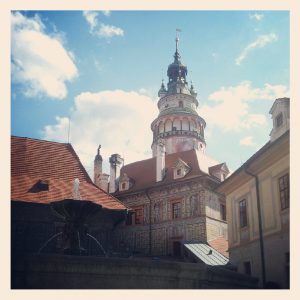 In the Little Castle and Castle Tower, which dates from the 13th century, there is a castle museum that opened to the public in January of 2011. Visitors can see stone statues and a copy of the Rožmberk tombstone made out of red marble in the lapidary. Other artifacts include illustrated manuscripts and panel paintings from the 14th century as well as rare books. Portraits of the Rožmberks, Eggenbergs and Schwarzenbergs abound, too. Because Český Krumlov had served as the main administrative center for the Schwarzenberg clan, a room has been designed as an 18th-century office with authentic furniture. Other spaces include a bedroom from a 19th or early 20th-century burghess house, a stunning dining room, and a treasury of sacred art that features recently restored Baroque reliquaries. An impressive armory plus a mint with 17th-century machinery round out the exposition.
In the Little Castle and Castle Tower, which dates from the 13th century, there is a castle museum that opened to the public in January of 2011. Visitors can see stone statues and a copy of the Rožmberk tombstone made out of red marble in the lapidary. Other artifacts include illustrated manuscripts and panel paintings from the 14th century as well as rare books. Portraits of the Rožmberks, Eggenbergs and Schwarzenbergs abound, too. Because Český Krumlov had served as the main administrative center for the Schwarzenberg clan, a room has been designed as an 18th-century office with authentic furniture. Other spaces include a bedroom from a 19th or early 20th-century burghess house, a stunning dining room, and a treasury of sacred art that features recently restored Baroque reliquaries. An impressive armory plus a mint with 17th-century machinery round out the exposition.
Theatre tradition in Český Krumlov
That is not all the castle complex has to offer. The Baroque theatre is one of the oldest Baroque theatres in Central Europe and one of the best-preserved Baroque theatres in the world. Theatre in Český Krumlov has a long, rich tradition, going back to the 15th century. During the second half of the 16th century, theatre flourished in the town with performances of Greek classics as well as German, Latin, and Czech dramas.
The Baroque theatre
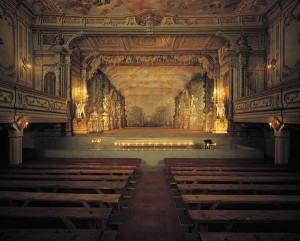 This theatre was built in 1682 by Johann Kristián von Eggenberg and then restored in 1766 by Josef Adam von Schwarzenberg. After its reconstruction, the building held performances of French and Italian comic operas, German dramas, pantomime, and ballet with themes from antiquity. In 1898 it was closed, only occasionally to be used for festivals in the 1950s and 1960s. In 1966 it was shut down again and did not reopen until 1997. Nowadays, performances take place here several times a year, with actors wearing Baroque attire.
This theatre was built in 1682 by Johann Kristián von Eggenberg and then restored in 1766 by Josef Adam von Schwarzenberg. After its reconstruction, the building held performances of French and Italian comic operas, German dramas, pantomime, and ballet with themes from antiquity. In 1898 it was closed, only occasionally to be used for festivals in the 1950s and 1960s. In 1966 it was shut down again and did not reopen until 1997. Nowadays, performances take place here several times a year, with actors wearing Baroque attire.
Sets, special effects, props, and more
There are 13 basic sets, such as those depicting a forest, military camp, garden, Baroque hall, port, town, prison, and temple. The set of the temple features flying putti suspended blue clouds and spiraled columns reaching into the horizon. Some 50 special effect machines have been preserved. Turning a lever of one machine produces the sound of the wind. Pushing another machine makes the rumble of thunder. Under the stage the visitor sees how scenery changes were made within eight to 12 seconds, incorporating winches, pulleys, and ropes that are attached to the side wings. The inventory also includes 573 original costumes and 2,400 props, stage, and lighting equipment. Winches, pulleys, a sliding platform, and ironwork date back to the Baroque era, too. There is even a Baroque music stand in the orchestra pit. Some 60 percent of stage machinery functions today. All the texts from the 17th, 18th and 19th centuries have been saved, accounting for more than 2,400 volumes of plays, operas, ballets, and more.
The chateau park
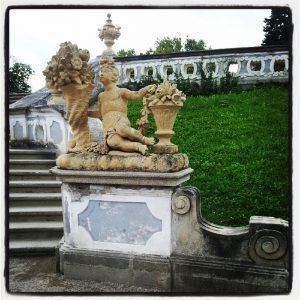 On the way from the Baroque theatre to the park, stop to admire the view of the orange rooftops dotting the town as adventurers paddle down the Vltava River, and notice the dominant spire of the former Saint Jošt Church. The chateau’s Baroque park boasts ornate statuary decorating its 18th-century, four-tiered, cascade fountain, Neptune perched at the top. Twenty decorated vases also adorn the park. A revolving auditorium used for performances in the summer and the Bellaire summerhouse is also on the grounds. Straight out of a Claude Monet painting, a pond covered in water lilies is another attraction.
On the way from the Baroque theatre to the park, stop to admire the view of the orange rooftops dotting the town as adventurers paddle down the Vltava River, and notice the dominant spire of the former Saint Jošt Church. The chateau’s Baroque park boasts ornate statuary decorating its 18th-century, four-tiered, cascade fountain, Neptune perched at the top. Twenty decorated vases also adorn the park. A revolving auditorium used for performances in the summer and the Bellaire summerhouse is also on the grounds. Straight out of a Claude Monet painting, a pond covered in water lilies is another attraction.
The Revolving Auditorium
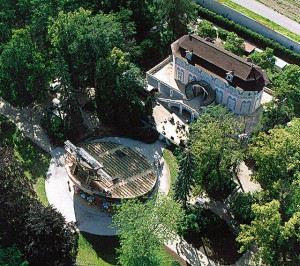 During summer nights, plays, operas, and ballets are performed outside at the Revolving Auditorium, situated in front of the Bellaire summerhouse. Shakespeare’s works are often staged here. The first performance harkens back to June 8, 1958, when the theatre could accommodate 60 spectators. A year later the theatre was enlarged to a capacity of 400 spectators. At that time 40 people had to manually drive the auditorium back and forth. In 1960 the theatre was reconstructed again, and this time it had seating for 550 people. An electric motor was also installed. The last reconstruction occurred from 1989 to 1993, and the theatre opened in 1994. Now it seats 640 spectators and weighs 650 tons. The elevation is almost eight meters, and four electric motors are used. From 1958 to the present, more than 1,700,000 spectators have watched almost 3,000 performances.
During summer nights, plays, operas, and ballets are performed outside at the Revolving Auditorium, situated in front of the Bellaire summerhouse. Shakespeare’s works are often staged here. The first performance harkens back to June 8, 1958, when the theatre could accommodate 60 spectators. A year later the theatre was enlarged to a capacity of 400 spectators. At that time 40 people had to manually drive the auditorium back and forth. In 1960 the theatre was reconstructed again, and this time it had seating for 550 people. An electric motor was also installed. The last reconstruction occurred from 1989 to 1993, and the theatre opened in 1994. Now it seats 640 spectators and weighs 650 tons. The elevation is almost eight meters, and four electric motors are used. From 1958 to the present, more than 1,700,000 spectators have watched almost 3,000 performances.
Other places to visit at the castle
On the castle grounds, it is also possible to climb the tower with the brightly decorated Renaissance facade, see art exhibitions, and gaze at the bears in the moat. The New Burgrave’s House, now housing the library, boasts murals created with the chiaroscuro technique. To be sure, Český Krumlov’s castle is a sight not to be missed and certainly one of the most intriguing places in the Czech lands.




